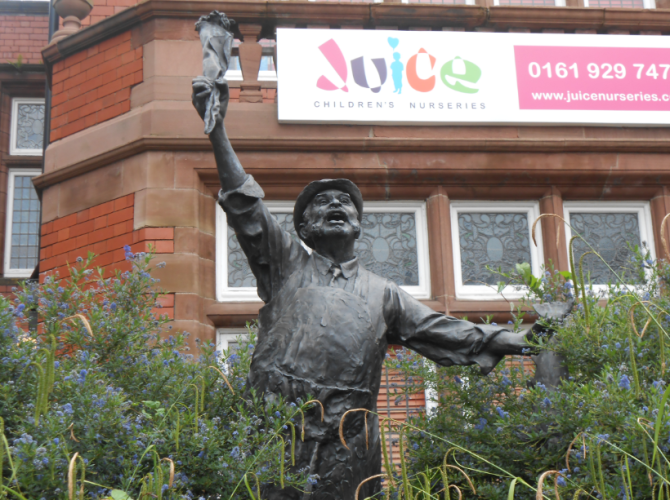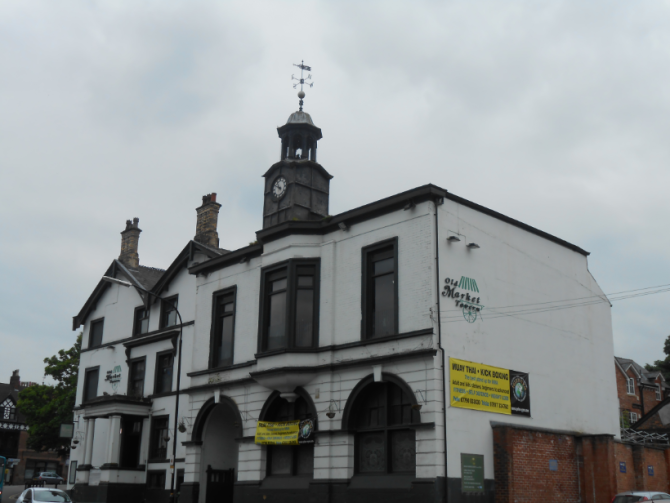Changing at Deansgate-Castlefield Metrolink Station in Central Manchester, we got a tram though to the Market Town of Altrincham, in the far south of Greater Manchester. It was a reasonably short journey, and when we arrived we set out to explore…
Altrincham:
Status: Trafford District, Greater Manchester (Historically Cheshire), Town, England
Date: 30/05/2014
Travel: Metrolink (Oldham King Street – Altrincham, via Deansgate-Castlefield), Metrolink (Altrincham – Stretford, via Sale)
Eating & Sleeping: Cafe Nero’s
Attractions: Market Cross, Clock Tower, Market Hall, Market Square, Station Hotel, Station Buildings, Old Market Square, Old Town Hall, Market Cross, Stocks etc
Altrincham station is a combined Metrolink and National Rail station, with Trams and Northern Rail trains sharing the platforms. The station itself was undergoing a refurbishment when we visited, hence the mini construction site outside, however the surrounding buildings were still visible, and I will get to them in a moment.
The original station opened was by the Manchester, South Junction & Altrincham Railway in 1881, and was called Altrincham & Bowdon Railway Station. It was rebranded as simply Altrincham in 1974, and after the Metrolink opened a few decades later, the station was expanded to incorporate it, and it became an interchange in 1992. Metrolink has two platforms, as do mainline trains, on the line between Manchester and Chester, via the town of Stockport.
Outside the station is the slender form of the brick Clock Tower, and was added in 1880 with the building of the station itself. It is known as a three stage Clock Tower, with the main base, main body and Clock each counting as 1 stage. There are clock faces on all four sides, and the detail on all the stages is very impressive. Behind the Tower is the beautiful form of Stamford House, encompassing numbers 1 – 11 Stamford New Road. This fine structure was completed in 1905, and at the time was called Station Buildings, and was built for J. H. Brown Esquire by Charles Heathcote & Sons (Architects from Manchester) as a large office block, one of the first in the town. The building was also being refurbished, and when it reopens it will contain a number of apartments. Thankfully the restoration is carefully preserving all the old features, and it blends in well with the Clock Tower, despite the 25 years between them.
Across the road from Stamford House is The Station Hotel, a fine late 19th century Grade II listed building, that along with Stamford House and the Clock Tower forms a small conservation area. So far I am unable to find out an exact day for when it opened,but what I do know is that the pub was formerly called the Famous Old Porter House.
From the conservation area we walked through to the Market Quarter, which contains most of the other attractions in the town centre. Altrincham has been a Market Town for centuries, since a charter was granted in 1290 by Baron Hamon de Massey V, granting the right to hold a weekly market. It is also possible the town was planned, using the market to establish the town and get income from trade taxes as well as toll roads. This was unusual at the town and is akin to the planned towns today such as Milton Keynes.
The sign above gives the times the different Markets are held:
Market: Tues, Thurs, Fri, Sat
Farmer’s Market: 1st Fri of Every Month
Antiques Fair: Every Thursday
The Market shows there is a wide range of activities associated with it in the town, and the longevity of the Market has recently been celebrated, as all around the town there are signs showing 1290 – 1990 marking 700 years since the Market began. There are even some paving stones on the floor with this engraved into them, as shown above. Altrincham is very proud of it’s past, and keeping the Market going all this time is very impressive.
A lot of the Market area is pedestrianised, but we soon emerged back onto the road at the far side, next to Altrincham Market House, built in 1879, by a gentlemen named Martin Stone, who also built one of the other very important buildings in the town, which just so happens to be sat opposite the Market House, just down the road. At the far side of the building, off to the right you can just see the top of a glass canopy, which was originally an open Market to go along with the House. It was glazed over in 1930, and a Saturday Market started 2 years later, in 1932.
This is the more modern meeting place for the Market, along with the surrounding streets, however further up the road is the Old Market Square, where we were heading next.
On route, we passed Mr Stone’s second important building, Altrincham Town Hall. The Hall was built 21 years after the Market House, in 1900, 5 years after the town gained an urban district council to represent it. The Hall replaced the previous Town Hall from 1849, built by Lord Stamford in the Old Market Place, which we shall see in a minute.
Outside the current Town Hall stands a large bronze statue, and is called simply “The Altrincham Market Trader”. He holds a bunch of flowers in his right hand, and a fish in the other. Unveiled by the Mayor of the Trafford District, Mark Rubin, in 2008, the statue celebrates the towns Market and the “Historic Market Quarter”.
So here we are, the site of Altrinchams Old Market, and this area is also though to be the site of the original settlement here. There are so many interesting things in this square, its hard to know where to start. To make it easy, lets go from left to right.
At the far left is the Brooks Bank building, built in 1870 out of Sandstone, with a mock Tudor upper story. It was built for W C Brooks, and opened as the Cunliffe Brooks Bank. The left chimney bears the initials WCB, and one of the main features of the building is the 32 feet high window, presumably on the other side of the building. House to the left and the right housed the senior company employees. The Bank was eventually taken over by Lloyds around 1900 and today the building is still in perfect condition, although I am unsure of its current function.
Next to the Bank on the right is the green front of the Olive Olive Restaurant Bar & Grill, one of the employee houses. In front of that is the 1990 replica Butter Cross, which originally stood here in the 17th century. The Buttermarket was created here in 1684, and was in use until around 1850, with dairy products mainly sold here.
Just behind the large tree is the Orange Tree, which has been a pub since the 1880’s, and is spread across two old buildings, separated from the next building along by an alleyway.
On the far side of the alleyway is the Old Market Tavern, originally called the Unicorn from its opening in the early 19th century.
Under the tree in the square is a set of Wooden Stocks, a replica of the original ones from 1838 (out of use by 1866), which were put up at the same time as the replica Cross. The lintel from the originals was incorporated into the new set, making the base over the stocks original. A Courtroom over looked the square, and included the stocks as well as a whipping post for punishing prisoners.
I mentioned earlier about the building formerly known as the Unicorn. This joined onto the original Town Hall from 1849, and toady the two buildings are both the Old Market Tavern. Being honest I prefer the old Town Hall, just for the architecture involved and the great little Clock Tower on top. It isn’t as grand as the newer version but if it was still the Town Hall then it would seem quite fitting.
We started circling back around to the train station, and passed the Church of St George’s, the local Anglican Parish Church. It is covered by the Diocese of Chester, and is the successor to the previous church here, a chapel built in 1799, as a part of the Parish of St Mary’s in the nearby village of Bowdon, which still exists today.
The oldest sections of the present church date back to 1874, when the main Tower and Spire were built, with the Chancel following in 1886. The other main sections of the Church, the Nave and the Aisles, were rebuilt between 1896 and 1897 by Austin and Pailey (Architects from Lancaster), making these sections the newest. The building has its roots in the Sunday School run by Oswald Leicester from 1783, and led to the building of the Church. Leicester was the son of Oswald Leicester Senior, a local Grocer.
That was the end of our trip to the charming town of Altrincham. Whilst it has its main roots in being a Market Town, there is much more to its history:
From 1765 with the arrival of the Canals, most notably the Bridgewater Canal in 1761, Altrincham became a Canal Town, with many goods passing through into Manchester.
Industrial activity in the town increased, with a more than 100% population increase between 1851 and 1881, and a large industrial area was formed in 1885 to encourage business growth in the town.
Altrincham is full of history, and a very proud town. It is the terminus of a branch of the Manchester Metrolink, with local trains into Chester and Manchester with easy changes from there to Liverpool, London, Salford, Oldham, Rochdale and many more. It is one of the closest towns to Manchester Airport, which is only 5 miles away by road. The town is just outside the M60 Manchester Ring Road, but next to the M56, which runs past the Airport and connects up with both the M60 and M6 (For Scotland, the North and Birmingham). We enjoyed our time in the historic Cheshire town, but it was time to move on, and we started moving back towards Manchester, stopping at the next town along, also in Cheshire, called Sale…












Altrincham used to be a fabulous thriving town. It’s looking very shabby now. Killed off by out of town shopping malls.
Yeah sadly I fear that is happening to a lot of places now, hopefully with some investment we can revive town centres eventually. Was still interesting to visit Altrincham 🙂